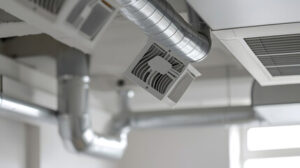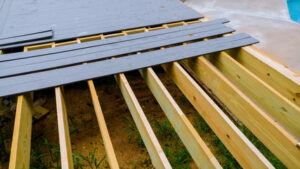Air Duct Cleaning Salt Lake City is an important part of maintaining the cleanliness of your home. It can improve your indoor air quality and help reduce allergy and asthma symptoms.

Before the air duct cleaners arrive, make sure to clear the area around your vents and registers. This will ensure that they can access all areas of your ductwork without obstruction.
Air Duct Cleaning Process
Duct cleaning is the process of thoroughly removing dust, dirt, and debris from your home’s ventilation system. The ductwork system, responsible for heating and cooling your home’s air before it enters each room, can become filled with pollutants like dust mites, mold spores, pet dander, and dust. If left uncleaned, these contaminants can aggravate respiratory conditions and even cause health problems like asthma.
The air duct cleaning process is typically done by trained technicians who use specialized equipment. The first step is to inspect your ductwork, using cameras and other tools to locate areas of contamination and identify issues like leaks or loose connections. Then, the technicians will use a high-powered vacuum to remove dirt and debris from inside your ducts and vents. After the ducts are clean, they will perform a final inspection to make sure everything is tidy and all debris has been removed.
While you can clean your ducts to some extent yourself, it’s best left to professional cleaners who have the right tools for the job. It’s also recommended that you clear all your vents before your cleaner arrives, to ensure they can easily access them. This is especially important if you have pets, who may shed as they are being cleaned and can block airflow in the house.
Some duct cleaning services offer additional services to help improve your indoor air quality. These services often include applying chemical biocides to ductwork and other system components to kill germs and prevent future biological growth. They may also propose applying a sealant to encapsulate or cover the surfaces of your ducts and other system components to prevent the release of dust particles and fibers into your living space.
While these services are marketed as ways to improve your home’s indoor air quality, they have not been proven to reduce respiratory problems or other health issues in any scientific studies. However, many people find that their homes become significantly less dusty after having their ducts cleaned and that their energy bills are reduced as well. If you have concerns about the state of your ductwork or your home’s indoor air quality, speak with your doctor for advice.
Air Duct Cleaning Results
Your air duct cleaners will use the truck-powered vacuum to suck up the dust and debris from your home’s ductwork system. This is a fairly messy job, and the resulting dust can be spread around your home. If there are valuable or sentimental items in the way, you may want to move them before the duct cleaning begins. In addition, if you have pets or children, you will need to keep them away from the area while the vacuum is in operation.
After the ductwork has been agitated with mechanical brushes and sucked up with the truck-powered vacuum, the technician will inspect the ductwork to see if any further cleaning is required. If any problems are found, the service provider will advise you on the necessary repairs.
If you suffer from allergies, a professional cleaning of your home’s air ducts may help reduce the symptoms. Dirty ducts can blow around the very things that trigger your allergies, such as pet dander and dust. This can cause your sneezing and stuffy nose to flare up. A duct cleaning will get rid of the offending substances and could significantly cut down on your allergy symptoms.
While professional duct cleaning should not require any major preparation by the homeowner, it’s helpful to tidy up a bit in advance of the service. This can make it easier for the technician to access your vents and HVAC equipment. It’s a good idea to move any fragile or valuable items out of the way, and you should clear a path to the ductwork from your furnace, attic, basement, garage, or utility room.
Some duct cleaning services offer additional services such as applying a chemical biocide to the inside of your ducts to kill germs and fungus or sealing leaky ducts with a polyurethane sealant. While this is an optional extra, it’s important that you fully understand the pros and cons of these treatments before agreeing to them. No evidence applying these chemicals to your ducts will prevent respiratory health problems, and in fact, the use of such biocides and sealants has been linked to an increased incidence of asthma and other respiratory issues in children and adults.
Air Duct Cleaning Cost
Air duct cleaning removes harmful contaminants and microorganisms from a home’s air conditioning system. These include pet dander, bacteria, mildew, and mold spores. These toxins are often inhaled by household members and can cause respiratory problems, including wheezing and difficulty breathing. Regular air duct cleaning prevents these contaminants from being circulated throughout the house and helps promote better indoor air quality.
When hiring an air duct cleaner, it’s important to ask about their process and costs before agreeing to service. They should be able to provide you with a detailed estimate of the work that will be done. This will help you compare quotes from different companies and ensure that you are getting the best value for your money.
Some companies may charge a per-square-foot fee for their services, while others may quote an hourly rate. In either case, the cost of the service will depend on several factors, including:
The size of your home or building: Larger structures tend to have more vents and ducts than smaller ones, and they can take longer to clean.
Your level of cleaning: If you have severe contaminant buildup, the technicians will need to spend more time on the job and may require special equipment to get rid of it.
Preparation: You will need to clear a path for the technicians to access your vents and registers. This means moving any furniture that might block their way or otherwise interfere with the ductwork. You should also make sure that all doors and windows are open so that the technicians can access all rooms of your building.
Rodent infestation: If you have evidence of a rodent infestation, the technicians will need to hire a pest control company to treat and exterminate the problem before proceeding with duct cleaning. This can add $150 to $500 to the total cost of the service.
Air Duct Cleaning Tips
Air duct cleaning involves taking specialized equipment to every vent and opening, vacuuming out the insides, and brushing any accumulated debris. Depending on the size of your home, it can take a couple of hours to complete the process. It’s important to decide ahead of time if you will be at home during the procedure or if your children or pets will be around. If your pets are at home, the technician will likely want to secure them in a single room before proceeding with the cleaning. This is a safety precaution to ensure that the animals aren’t exposed to any loud machinery during the process.
If you’re planning to be at home, make sure that any furniture is moved away from the vents so that the technicians can access them easily. It’s also a good idea to have any toys or clutter cleared out of the areas directly underneath your vents as well. This will make it easier for the crew to access the ducts and prevent any items from falling or getting dirty during the process.
While duct cleaning does help to reduce home allergens and improve air quality, it’s impossible to eliminate all contaminants from your home. As such, it’s recommended to schedule regular duct cleanings for optimal indoor air quality. The average home should get a duct cleaning every 3-5 years, though it’s not unusual to schedule them more frequently for homes with severe allergies or asthma or in cases of construction or remodeling.
Even if you regularly dust and clean your home, fine particulate contaminants will spread throughout the house faster when your ducts are dirty. They will cling to tables, smartphones, and kids’ toys, as well as the surfaces of your air conditioning system, furnace, and heating unit. The particles then circulate through the house, affecting your family’s health and causing allergy symptoms and other problems.
If you’re planning to remodel your home or build a new one, consider hiring an air duct cleaner to get the job done right. Construction is messy, and unless contractors are careful to seal off work areas and keep their equipment clean, the dust will make its way into your air ducts. It’s also a smart decision to hire a professional air duct cleaner to clean your home after a fire or flood as well as to address mold growth or signs of vermin infestations in the ductwork.








